Wildlife Notes
4. Beautiful Brimstone

Canon 40D
Canon 300mm F4 IS plus 1.4 x Extender
1/250th
F10
ISO 320
Fill Flash – 2 1/3
Tripod
Because we’re still just about holding onto summertime here in the UK (late August), for this article, I decided to keep the insect theme going for one last time this year. My subject is, for me, one of our most iconic butterflies – The Common Brimstone (Gonepteryx rhamni). It's one of my absolute favourites, even when I’m without a camera it never fails to stop me in my tracks, I just have to spend time and get a close look.
The Brimstone is one of the most mentioned butterflies in historical writings and many attribute the general Anglo Saxon term Butterfly to the yellow of this species, the fact it was once perhaps the most common species and that its appearance coincided with the early spring ‘butter season’.

Canon 50D
Canon 300mm F4 IS plus 1.4 x Extender
1/125th
F13
ISO 200
Tripod
The Common Brimstone is a butterfly of the Pieridae family. In much of its range it is the only species of its genus and therefore, locally, simply known as "the brimstone".
Found in Europe, Asia, and even North Africa it is one of the longest lived butterflies, living up to thirteen months, although most of this time is spent in hibernation.
On the upper side the male is sulphur yellow and the female white with a greenish tinge but both have an orange spot in the centre of each wing. They never settle with their wings open and from the underside the sexes are more difficult to separate but the female is still paler. At colder times of year they rest at right angles to the sun to absorb maximum heat. Their wing shape is unique among British butterflies (although there are similar, closely related species in Southern and Eastern Europe) and is designed to act as camouflage while they rest and during hibernation. Widely distributed across the southern half of the UK, it has been steadily increasing its range in the north of England but is limited by the distribution of its larval food plants and is quite possibly close to its maximum possible distribution now unless their food plants range also increases. In Ireland it has a much more localised distribution and has its own subspecies designated ‘gravesi’ as opposed to ‘rhamni’. It is often the first butterfly to be seen in the spring, sometimes as early as January when hibernating adults (usually eager males) are awoken on a sunny day.
The males are the first to emerge in the Spring and soon begin patrolling for females. When a suitable female is found the pair spiral high, often out of sight, before tumbling back to into a bush to mate.
The eggs are laid singly on the leaves of either Common Buckthorn or Alder Buckthorn - the only two food plants - and females will wander far and wide in search of them. Apparently they are also very fussy about which plant and leaf they lay their eggs on, ignoring many before finding the one that’s ‘just right’ for their future brood. It is not uncommon for more than one female’s eggs to be laid on the underside of a particularly attractive leaf. The eggs hatch after one or two weeks and over the next month the feasting larvae undergo 4 moults. The larvae and Pupae are both green and very well camouflaged (the pupae is an exquisite curved leaf shape) making them difficult to spot, though the remnants of a much chewed leaf can give their position away.
After around two weeks the adult, imago, butterfly emerges to spend the summer feeding on nectar building up energy reserves for the coming winter and by the end of August they are already beginning their long sleep. For hibernation they seek out evergreen scrub, a favourite being dense, old Ivy growth. There is only one brood a year.

Canon 50D
Canon 300mm F4 IS plus 1.4 x Extender
1/200th
F13
ISO 320
Fill Flash -2 2/3
Tripod
Peak flying times are usually April/May and August. August is particularly good when the pristine current year adults feed avidly building reserves for their coming hibernation. The adults wander widely and can be found in a range of habitats feeding on a variety of nectar rich flowers, particular favourites are purple nectar flowers such as Knapweed, Thistles and Buddleia. Emerging adults from hibernation rely on the nectar of spring Dandelion, Primrose, Cowslip, Bugle and Bluebell.

Canon 40D
Canon 300mm F4 IS plus 1.4 x Extender
1/250th
F10
ISO 320
Fill Flash -2 2/3
Tripod

Canon 40D
Canon 300mm F4 IS plus 1.4 x Extender
1/400th
F13
ISO 400
Fill Flash -2 2/3
Tripod
The first time I captured a good image of this butterfly and viewed it close-up on the PC I was amazed at the eye patterning, purple colour wing base edgings, clubbed antennae (which butterflies use to smell, while they taste with their feet!) and its overall hairiness. What really appeals to me the most though is the green colour of the females and the lovely sculptured wing shape.
Brimstones are in the main very approachable and tolerant if you are careful and move slowly. They produce excellent images, and to my eye, their colour provides a great combination with numerous backgrounds and flowers, they also make super backlight subjects. Being comparatively big butterflies you don’t need a macro lens to get good images, your normal walkabout telephoto zoom will do the job.
Despite their beauty and perceived fragility I think they must be relatively rugged butterflies, you very rarely see ‘raggedy’ damaged specimens. Once you've located a hot spot for them, they are very reliable in appearing year after year.
Being comparatively large and strong fliers they are also easy to spot, unlike some species which skulk around they fly high and confidently between feeding or resting spots. Once they land they tend to stay put resting or feeding for a good period of time providing ample photographic opportunities.
Along with general internet research the following source was used in the completion of the natural history elements of this article.
Link To – UK Butterflies

Canon 20D
Canon 300mm F4 IS plus 1.4 x Extender
1/250th
F13
ISO 400
Fill Flash -2 1/3
Tripod
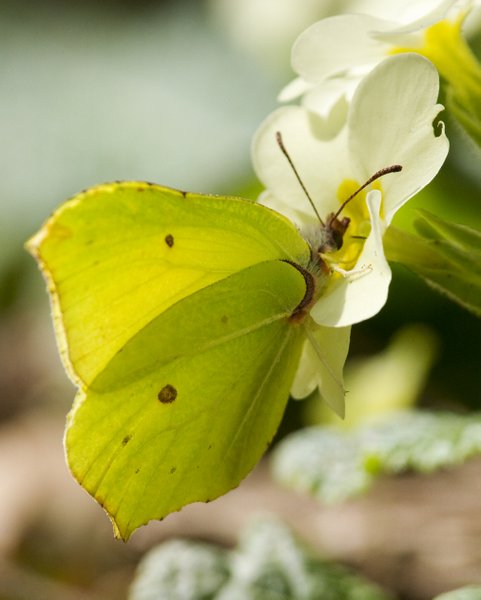
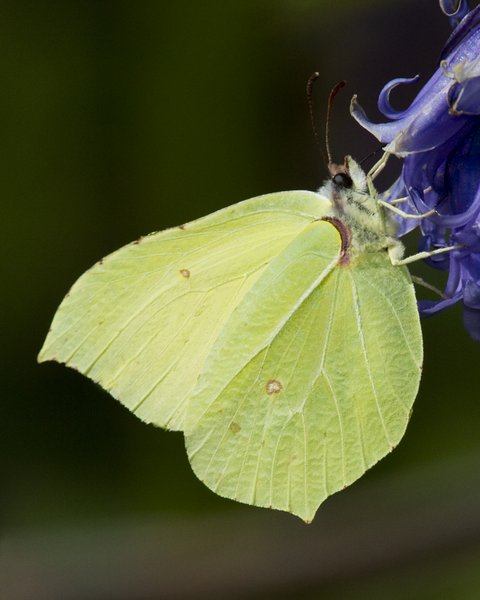
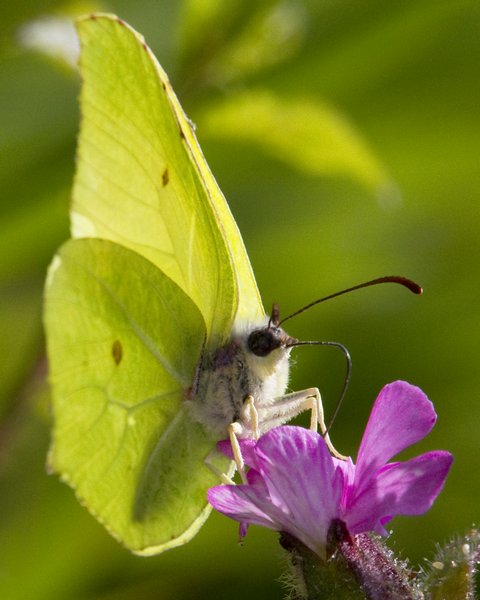
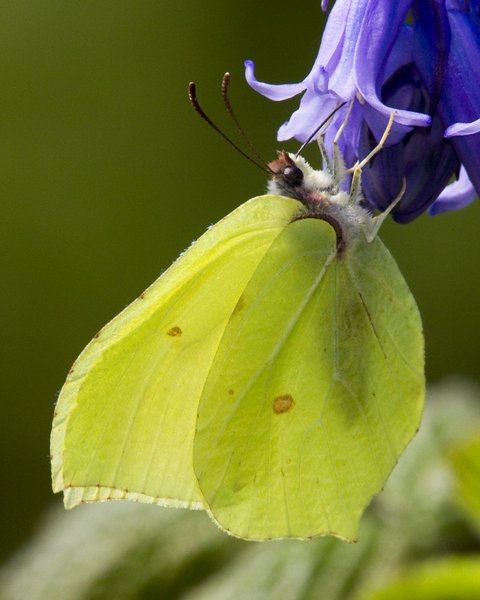
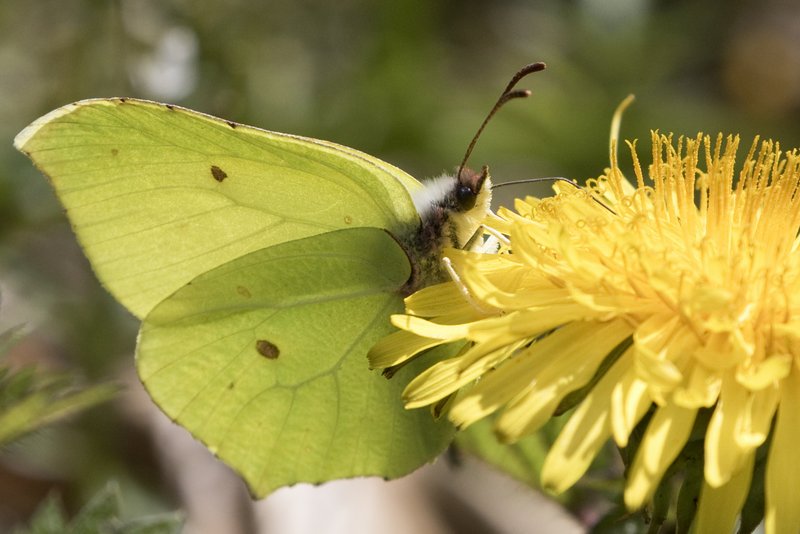

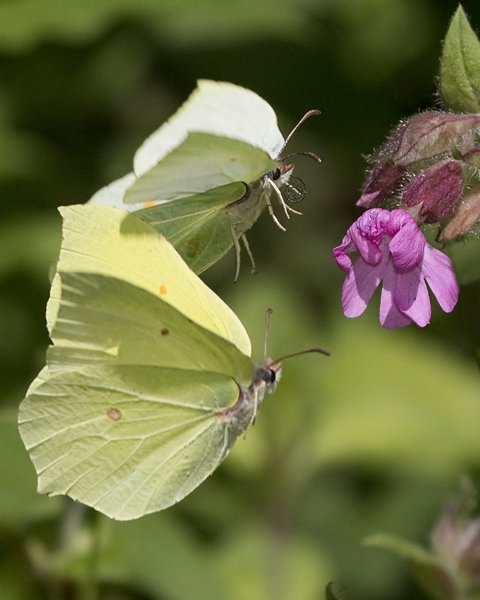


Tweet
Follow @Naturelens
Canon 300mm F4 IS plus 1.4 x Extender
1/250th
F10
ISO 320
Fill Flash – 2 1/3
Tripod
Because we’re still just about holding onto summertime here in the UK (late August), for this article, I decided to keep the insect theme going for one last time this year. My subject is, for me, one of our most iconic butterflies – The Common Brimstone (Gonepteryx rhamni). It's one of my absolute favourites, even when I’m without a camera it never fails to stop me in my tracks, I just have to spend time and get a close look.
The Brimstone is one of the most mentioned butterflies in historical writings and many attribute the general Anglo Saxon term Butterfly to the yellow of this species, the fact it was once perhaps the most common species and that its appearance coincided with the early spring ‘butter season’.

Canon 50D
Canon 300mm F4 IS plus 1.4 x Extender
1/125th
F13
ISO 200
Tripod
The Common Brimstone is a butterfly of the Pieridae family. In much of its range it is the only species of its genus and therefore, locally, simply known as "the brimstone".
Found in Europe, Asia, and even North Africa it is one of the longest lived butterflies, living up to thirteen months, although most of this time is spent in hibernation.
On the upper side the male is sulphur yellow and the female white with a greenish tinge but both have an orange spot in the centre of each wing. They never settle with their wings open and from the underside the sexes are more difficult to separate but the female is still paler. At colder times of year they rest at right angles to the sun to absorb maximum heat. Their wing shape is unique among British butterflies (although there are similar, closely related species in Southern and Eastern Europe) and is designed to act as camouflage while they rest and during hibernation. Widely distributed across the southern half of the UK, it has been steadily increasing its range in the north of England but is limited by the distribution of its larval food plants and is quite possibly close to its maximum possible distribution now unless their food plants range also increases. In Ireland it has a much more localised distribution and has its own subspecies designated ‘gravesi’ as opposed to ‘rhamni’. It is often the first butterfly to be seen in the spring, sometimes as early as January when hibernating adults (usually eager males) are awoken on a sunny day.
The males are the first to emerge in the Spring and soon begin patrolling for females. When a suitable female is found the pair spiral high, often out of sight, before tumbling back to into a bush to mate.
The eggs are laid singly on the leaves of either Common Buckthorn or Alder Buckthorn - the only two food plants - and females will wander far and wide in search of them. Apparently they are also very fussy about which plant and leaf they lay their eggs on, ignoring many before finding the one that’s ‘just right’ for their future brood. It is not uncommon for more than one female’s eggs to be laid on the underside of a particularly attractive leaf. The eggs hatch after one or two weeks and over the next month the feasting larvae undergo 4 moults. The larvae and Pupae are both green and very well camouflaged (the pupae is an exquisite curved leaf shape) making them difficult to spot, though the remnants of a much chewed leaf can give their position away.
After around two weeks the adult, imago, butterfly emerges to spend the summer feeding on nectar building up energy reserves for the coming winter and by the end of August they are already beginning their long sleep. For hibernation they seek out evergreen scrub, a favourite being dense, old Ivy growth. There is only one brood a year.

Canon 50D
Canon 300mm F4 IS plus 1.4 x Extender
1/200th
F13
ISO 320
Fill Flash -2 2/3
Tripod
Peak flying times are usually April/May and August. August is particularly good when the pristine current year adults feed avidly building reserves for their coming hibernation. The adults wander widely and can be found in a range of habitats feeding on a variety of nectar rich flowers, particular favourites are purple nectar flowers such as Knapweed, Thistles and Buddleia. Emerging adults from hibernation rely on the nectar of spring Dandelion, Primrose, Cowslip, Bugle and Bluebell.

Canon 40D
Canon 300mm F4 IS plus 1.4 x Extender
1/250th
F10
ISO 320
Fill Flash -2 2/3
Tripod

Canon 40D
Canon 300mm F4 IS plus 1.4 x Extender
1/400th
F13
ISO 400
Fill Flash -2 2/3
Tripod
The first time I captured a good image of this butterfly and viewed it close-up on the PC I was amazed at the eye patterning, purple colour wing base edgings, clubbed antennae (which butterflies use to smell, while they taste with their feet!) and its overall hairiness. What really appeals to me the most though is the green colour of the females and the lovely sculptured wing shape.
Brimstones are in the main very approachable and tolerant if you are careful and move slowly. They produce excellent images, and to my eye, their colour provides a great combination with numerous backgrounds and flowers, they also make super backlight subjects. Being comparatively big butterflies you don’t need a macro lens to get good images, your normal walkabout telephoto zoom will do the job.
Despite their beauty and perceived fragility I think they must be relatively rugged butterflies, you very rarely see ‘raggedy’ damaged specimens. Once you've located a hot spot for them, they are very reliable in appearing year after year.
Being comparatively large and strong fliers they are also easy to spot, unlike some species which skulk around they fly high and confidently between feeding or resting spots. Once they land they tend to stay put resting or feeding for a good period of time providing ample photographic opportunities.
Along with general internet research the following source was used in the completion of the natural history elements of this article.
Link To – UK Butterflies

Canon 20D
Canon 300mm F4 IS plus 1.4 x Extender
1/250th
F13
ISO 400
Fill Flash -2 1/3
Tripod









Tweet
Follow @Naturelens